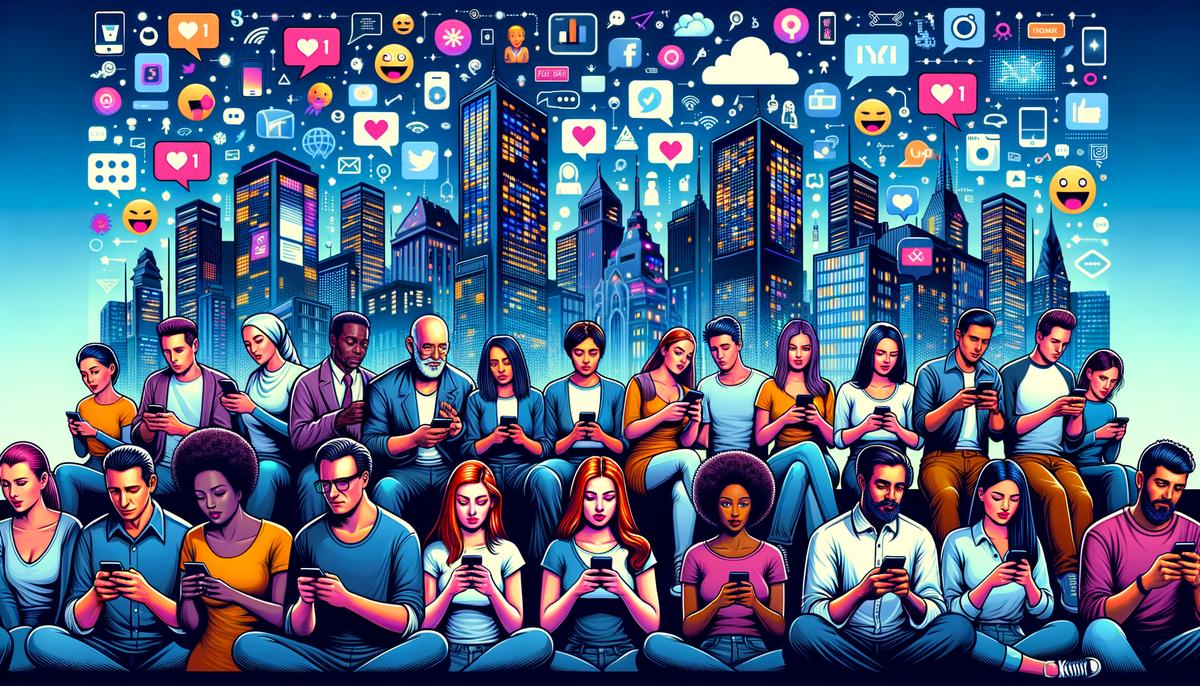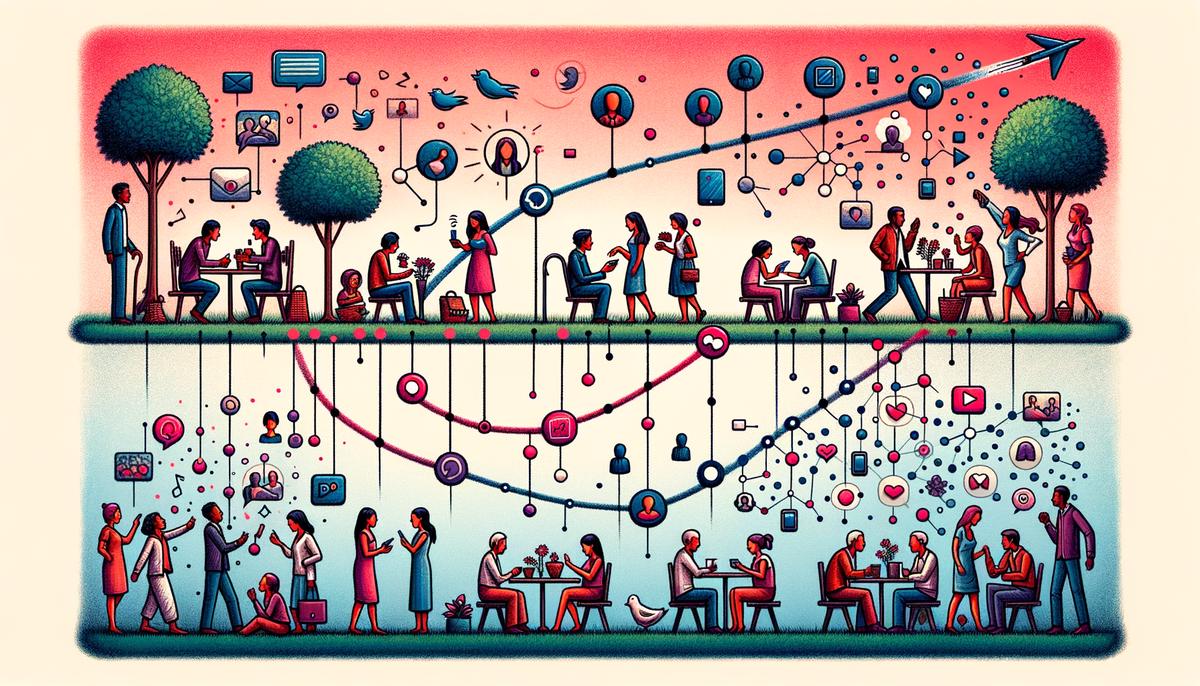- Cultivate Depth and Meaning: Deliberately seek to deepen relationships beyond superficial exchanges. Share experiences, aspirations, and fears to create a tapestry of connections rich with meaning and understanding.
- Practice Digital Empathy: Always remember there’s a human behind the screen. Cultivating empathy and kindness in online interactions fosters a more nurturing environment for relationships to flourish.
- Balance Is Key: While embracing the benefits of virtual connections, strive for a balance with in-person interactions. Physical presence has irreplaceable value in conveying emotions, building trust, and creating deep bonds.
- Be Mindful and Intentional: Use digital platforms with purpose and mindfulness. Aiming for quality over quantity in online friendships can lead to more fulfilling and lasting connections.
- Cultivate Online Safety: Trust and safety are paramount. Be judicious in sharing personal information and ensure that digital interactions are conducted in secure environments to maintain privacy and security.
- Embrace Authenticity: The curated nature of online personas can tempt individuals to present only their ideal selves. However, authenticity resonates profoundly. Dare to be genuine, sharing both strengths and vulnerabilities.
Strategies for Navigating Virtual Relationships
In an age where fingers glide over screens more fluently than pen on paper, the evolution of relationships through digital platforms is undeniable. This change, sweeping across the globe, has reshaped how we connect, communicate, and commit to one another. Digital platforms, with their infinite possibilities, have stretched the traditional boundaries of relationships transforming into a new era of human connection.
Redefining Relationships
Digital platforms have expanded the definition of relationships beyond romantic and familial ties. Online communities and forums provide a sense of belonging and support akin to physical relationships. The global village is now a reality, with friendships and mentorships forming without face-to-face interaction. These digital connections can be profound, challenging the notion that physical presence is paramount for a meaningful relationship.
The Future of Relationships in the Digital Realm

Psychological Effects of Virtual vs Real-Life Interaction
One pivotal aspect of virtual relationships is the concept of emotional intimacy and its development. In face-to-face interactions, nonverbal cues such as eye contact, body language, and physical touch play a crucial role in establishing and deepening emotional bonds. These elements are often absent in virtual interactions, which can lead to a different quality of connection. While technology allows for expressions of affection through words and digital gestures, the lack of physical presence can impede the full depth of emotional intimacy that is more readily achieved in person.
However, virtual relationships offer a unique advantage in terms of accessibility and convenience. For individuals with mobility issues, social anxiety, or those living in remote areas, digital platforms can serve as vital lifelines, providing a sense of community and connection that might otherwise be difficult to obtain. This accessibility underscores the importance of technology in bridging gaps and fostering inclusivity, highlighting how virtual connections can offer substantial psychological benefits by combating feelings of isolation and loneliness.
The anonymity and flexibility of online interactions also allow individuals to present themselves in a manner that they perceive as more ideal. This ability to curate one’s digital identity can have mixed implications. On one hand, it offers a space for exploration and self-expression, particularly for those who feel marginalized or misunderstood in their physical environments. On the other hand, this curated self-presentation can lead to discrepancies between one’s online persona and their offline reality, potentially hindering authentic self-expression and contributing to feelings of detachment and dissatisfaction.
Moreover, the immediacy and permanence of digital communication can have profound effects on psychological well-being. The expectation of constant availability can lead to increased stress and anxiety, as individuals may feel compelled to respond immediately to messages and notifications. This culture of instantaneity can diminish the quality of interactions, as thoughtful reflection is often sacrificed for rapid response, potentially leading to misunderstandings and conflicts that strain relationships.
In considering the psychological impacts of virtual versus face-to-face relationships, it is essential to recognize the role of empathy and understanding. Virtual interactions, devoid of physical presence and immediate feedback, can sometimes lead to a lack of empathy, as individuals may feel disconnected from the real-life implications of their words and actions. The screen acts as a barrier, making it easier to overlook the emotional impact on the person on the other end. Conversely, face-to-face interactions naturally foster empathy through direct engagement and shared experiences, strengthening emotional bonds and facilitating mutual understanding.
Authenticity and Depth in Relationships Online and Offline
In the exploration of how virtual and real-life settings influence the authenticity and depth of relationships, it becomes clear that the mode of interaction plays a pivotal role in shaping the dynamics of human connection. This discussion navigates through various aspects that differentiate virtual relationships from their real-life counterparts, emphasizing the nuanced interplay between technology and human emotion.
One fundamental area of consideration is the manner in which trust and security are established within relationships. In real-life interactions, trust often builds over time through shared experiences, non-verbal cues, and the mutual vulnerability that comes from physical co-presence. Face-to-face encounters allow individuals to observe subtle expressions, tones of voice, and body language, which contribute significantly to the depth of connection and understanding between people.
Conversely, virtual settings can present challenges to this depth, as the absence of physical presence necessitates relying on written or verbal communication alone. While video calls can mitigate this to some extent, they cannot fully replicate the intimacy of being in the same room. As a result, establishing trust in a virtual environment might demand more time and effort, relying heavily on consistent and open communication to overcome the lack of physical cues.
Another critical aspect to consider is the concept of shared experiences and how they foster closeness and authenticity in relationships. In real-life settings, doing activities together, whether as mundane as grocery shopping or as thrilling as traveling, creates memories and bonds that are deeply felt and remembered. These shared experiences contribute to a rich tapestry of relationship history that deepens the connection between individuals.
In virtual spaces, creating shared experiences requires creativity and intentionality. Online games, video watching parties, and virtual tours offer avenues for shared activities, but they inherently lack the spontaneity and multi-sensory engagement of real-world experiences. While meaningful connections can undoubtedly be forged virtually, the absence of shared physical experiences may lead to a different quality of relationship depth.
Communication patterns also diverge significantly between virtual and real-life interactions. The immediacy and convenience of digital communication allow for constant contact but can lead to superficial exchanges that lack depth and thoughtful engagement. The ease of sending a quick message contrasts with the effort required to meet someone in person, potentially leading to a preference for convenience over quality.
Furthermore, the potential for misunderstandings is heightened in virtual settings, where the absence of tone and non-verbal communication can lead to confusion and misinterpretation. In person, immediate feedback and the ability to clarify in real-time can prevent miscommunications from escalating.
Lastly, the personal effort and commitment displayed in real-life interactions inherently convey a level of investment in the relationship that can be less palpable in virtual contexts.


